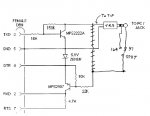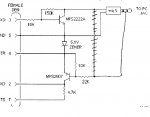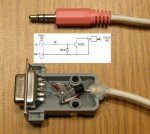Serial cable
Note that the difference between the PRO-163/PRO-164/PSR-300 and the PRO-97 in this regard is the PC/IF connector used. The PRO-97 uses a "mono" connector and the newer scanners use a "stereo" connector. Otherwise the radio models are quite similar and there's no other reason the circuit should not work.
The circuit I posted does not have any voltage on the scanner side - it is open collector. That is, there is no "drive" signal from the circuit. That's why it works on such a boad selection of scanners.As to adapting the original circuit you posted by separating the TX and RX, dosen't it have a 5 volt signal level on the scanner side? I would think it would not be useable for his Pro-163 either.
Note that the difference between the PRO-163/PRO-164/PSR-300 and the PRO-97 in this regard is the PC/IF connector used. The PRO-97 uses a "mono" connector and the newer scanners use a "stereo" connector. Otherwise the radio models are quite similar and there's no other reason the circuit should not work.
Sounds scary to me. USB ports are designed to provide external power. But I'd rather not deal with it at all, unless I am building a USB type cable.I mentioned that one way is to bring out a separate wire from an unused power connector. I think that would be better than tapping a USB port for power.
So you're building a cable that you'll leave on one computer. I've got 2+ desktops here in use all the time and a laptop for on the road. Rather than tap into a computer for power it might as well use a separate wall wart.Yes an extra wire to connect is a bit awkward but would work ok for a situation where a programming cable is attached to one computer and left there.
Gee, that reminds me I have such a device I designed for another customer. I'll have to look at it to see how easily it could be adapted to a scanner. But my device doesn't need the MAX232 either.there is a circuit that taps the RTS and DTR signals on the DB9 and uses a couple of capacitors and a TTL logic chip to provide 5 volt power to the MAX chip. I will post that if he is interested in doing it that way.
It appears to me (without reading the part spec) that the part can work at either 3.3v or 5v by powering it from that voltage. So if you ignore 5v scanners and power it from 3.3v that would work. But now you need 3.3v - 5v from the PC is more available.The description talks about a MAX232 chip but the picture shows an ADM3232 - I am not sure what is up with that and plan to email them to see what I actually would get.







